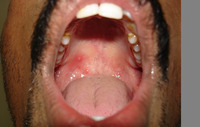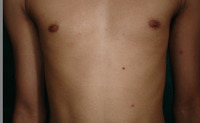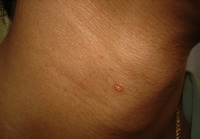×
You need to sign in or sign up before continuing.
Search
Search Results
-
| show more |
| Title: |
Herpes Zoster |
| Depositor: |
batchuser@i-human.com |
| Creator: |
Kristina DeRycke
i-Human Patients, Inc. |
| Abdominal herpes zoster rash |
| Keywords: |
Varicella Zoster Virus, Herpesvirus 3, Human, Dermatome, Unilateral Rash, Ganglia, Sensory, Chickenpox |
| Date Uploaded: |
05/27/2015 |
-

| show more |
| Title: |
Varicella |
| Depositor: |
batchuser@i-human.com |
| Creator: |
Dr. P.N. Girish, MBBS, MD, DDV, DNB
AJ Institute of Medical Science |
| Varicella - vesicle on an erythematous base over soft palate
An acute, highly contagious, viral disease, with mild constitutional symptoms and a maculopapular vesicular skin eruption; it is a common childhood disease and is rarely severe, but it can be accompanied by severe symptoms in infants and adults. It is usually spread by either contact with blisters or droplet infection, and the average incubation period is 10 to 16 days. The period of contagion lasts about two weeks, beginning two days before the rash appears. The causative virus is human herpesvirus 3 (formerly known as varicella-zoster virus). The same virus also causes herpes zoster (shingles), with the differences in the two diseases probably reflecting differences in the response to the virus. Called also varicella. |
| Keywords: |
varicella, DNA Virus Infections, Chicken pox, vesicular skin eruption, viral disease, Chickenpox |
| Date Uploaded: |
02/02/2014 |
-

| show more |
| Title: |
Varicella |
| Depositor: |
batchuser@i-human.com |
| Creator: |
Dr. P.N. Girish, MBBS, MD, DDV, DNB
AJ Institute of Medical Science |
| Varicella - multiple polymorphic papules and vesicles over trunk
An acute, highly contagious, viral disease, with mild constitutional symptoms and a maculopapular vesicular skin eruption; it is a common childhood disease and is rarely severe, but it can be accompanied by severe symptoms in infants and adults. It is usually spread by either contact with blisters or droplet infection, and the average incubation period is 10 to 16 days. The period of contagion lasts about two weeks, beginning two days before the rash appears. The causative virus is human herpesvirus 3 (formerly known as varicella-zoster virus). The same virus also causes herpes zoster (shingles), with the differences in the two diseases probably reflecting differences in the response to the virus. Called also varicella. |
| Keywords: |
Chickenpox, vesicular skin eruption, DNA Virus Infections, varicella, Chicken pox, viral disease |
| Date Uploaded: |
02/02/2014 |
-

| show more |
| Title: |
Varicella, Vesicles |
| Depositor: |
batchuser@i-human.com |
| Creator: |
Dr. P.N. Girish, MBBS, MD, DDV, DNB
AJ Institute of Medical Science |
| Vesicles - circumscribed skin elevation measuring < 1 cm containing clear fluid, e.g. varicella (chicken pox)
An acute, highly contagious, viral disease, with mild constitutional symptoms and a maculopapular vesicular skin eruption; it is a common childhood disease and is rarely severe, but it can be accompanied by severe symptoms in infants and adults. It is usually spread by either contact with blisters or droplet infection, and the average incubation period is 10 to 16 days. The period of contagion lasts about two weeks, beginning two days before the rash appears. The causative virus is human herpesvirus 3 (formerly known as varicella-zoster virus). The same virus also causes herpes zoster (shingles), with the differences in the two diseases probably reflecting differences in the response to the virus. Called also varicella. |
| Keywords: |
vesicles, vesicular skin eruption, varicella, Chickenpox, Chicken pox, DNA Virus Infections, viral disease |
| Date Uploaded: |
02/01/2014 |